Numerical Study of Endwall Modification with Micro-Scale Ribs in a Turbine Cascade
Abstract
:1. Introduction
2. Computational Methods
2.1. Verification of Turbulence Model
2.2. Mesh Generation and Grid Independence Analysis
3. Results and Discussions
3.1. Film Cooling Characteristic
3.2. Heat Transfer Characteristic
4. Conclusions
- (1)
- The rib-like vortex changed the flow of the coolant and had various impacts on the cooling characteristic. The cooling characteristic of the ribbed endwall performed generally better than the original endwall (excluding the horizontal rib). The difference between the ribs is caused by the layout of the rib, which is related to the direction of the local mainstream. Specifically, when the rib is parallel to the mainstream, it benefits the cooling characteristic, and vice versa.
- (2)
- The reason for the difference in phantom cooling among different ribbed endwalls is due to the flow guiding effect of ribs on the coolant and whether the coolant dissipated before it reached the SS of the blade. So, the vertical ribs exhibit the best phantom cooling performance compared with horizontal and tilted ribs. For the tilted ribs, the phantom cooling would not perform well, since the rib direction guided the coolant to the opposite direction. Horizontal ribs exhibited the worst phantom cooling performance for the dissipated coolant before reaching the SS of the blade. The case of vertical s = 8 mm had the best cooling performance on the endwall surface (an increase of 26.9%, compared with original endwall) and the SS of the blade.
- (3)
- Compared with the cooling characteristic, the heat transfer of the ribbed endwall mainly depends on the combination of the secondary flow and rib-like vortex. The horizontal and tilted rib interfered most with the mainstream and thus caused a negative impact on the heat transfer. The vertical rib had the smallest influence on the heat transfer characteristic, because the high-h region, caused by the PV, was inhibited by the vertical rib layout. In addition, the ribbed endwall increased the aerodynamic loss, which was present in different z/H positions.
Author Contributions
Funding
Institutional Review Board Statement
Informed Consent Statement
Data Availability Statement
Conflicts of Interest
Nomenclature
| PS | Pressure side |
| SS | Suction side |
| LE | Leading-edge |
| TE | Trailing-edge |
| PV | Passage vortex |
| MPG | Mid-passage gap |
| MFR | Mass flow ratio |
| Film cooling effectiveness | |
| x | x axial length |
| Cax | axial chord distance |
| P | pitch-wise |
| H | passage height |
| h | rib height, (mm) |
| s | rib spacing, (mm) |
| w | rib width, (mm) |
| M | blowing ratio |
| Re | Reynolds number |
| Um | Mainstream velocity, (m/s) |
| Tm,in | Temperature of mainstream inlet, (K) |
| Tc,in | Temperature of coolant inlet, (K) |
| Taw | Adiabatic wall temperature, (K) |
| Vorticity of z-direction | |
| u | velocity |
| h | heat transfer coefficient, (W/(m2·K)) |
| Heat flux, (W/m2) | |
| Heat flux on the endwall surface | |
| Total pressure loss coefficient | |
| Total pressure of mainstream | |
| Total pressure of local position | |
| Static pressure of outlet |
References
- Pasinato, H.D.; Squires, K.D.; Roy, R.P. Measurements and Modeling of the Flow and Heat Transfer in a Contoured Vane-Endwall Passage. Int. J. Heat. Mass. Transf. 2004, 47, 5685–5702. [Google Scholar] [CrossRef]
- Lynch, S.P.; Thole, K.A. The Effect of Combustor-Turbine Interface Gap Leakage on the Endwall Heat Transfer for a Nozzle Guide Vane. J. Turbomach. 2008, 130, 041019. [Google Scholar] [CrossRef]
- Oke, R.A.; Simon, T.W.; Burd, S.W.; Vahlberg, R. Measurements in a Turbine Cascade Over a Contoured Endwall: Discrete Hole Injection of Bleed Flow. In American Society of Mechanical Engineers Digital Collection; ASME Press: Munich, Germany, 2000. [Google Scholar]
- Mahmood, G.I.; Acharya, S. Measured Endwall Flow and Passage Heat Transfer in a Linear Blade Passage with Endwall and Leading Edge Modifications. In Proceedings of the ASME Turbo Expo 2007, Montreal, QC, Canada, 14–17 May 2007; Volume 6 Parts A and B. ASME: New York, NY, USA, 2007; pp. 917–930. [Google Scholar]
- Li, X.; Ren, J.; Jiang, H. Experimental Investigation of Endwall Heat Transfer with Film and Impingement Cooling. J. Eng. Gas. Turbines Power 2017, 139, 101901. [Google Scholar] [CrossRef]
- Choi, S.M.; Park, J.S.; Chung, H.; Park, S.; Cho, H.H. Upstream Wake Effect on Flow and Heat Transfer Characteristics at an Endwall of First-Stage Blade of a Gas Turbine. Exp. Therm. Fluid. Sci. 2017, 86, 23–36. [Google Scholar] [CrossRef]
- Xu, Q.; Du, Q.; Wang, P.; Liu, J.; Liu, G. Computational Investigation of Film Cooling and Secondary Flow on Turbine Endwall with Coolant Injection from Upstream Interrupted Slot. Int. J. Heat. Mass. Transf. 2018, 123, 285–296. [Google Scholar] [CrossRef]
- Zhang, L.; Yin, J.; Koo Moon, H. The Effects of Vane Showerhead Injection Angle and Film Compound Angle on Nozzle Endwall Cooling (Phantom Cooling). J. Turbomach. 2014, 137, 021003. [Google Scholar] [CrossRef]
- Yang, X.; Liu, Z.; Liu, Z.; Feng, Z.; Simon, T. Turbine Platform Phantom Cooling from Airfoil Film Coolant, with Purge Flow. Int. J. Heat. Mass. Transf. 2019, 140, 25–40. [Google Scholar] [CrossRef]
- Zhang, L.; Yin, J.; Liu, K.; Hee-Koo, M. Effect of Hole Diameter on Nozzle Endwall Film Cooling and Associated Phantom Cooling. In American Society of Mechanical Engineers Digital Collection; ASME Press: Montréal, QC, Canada, 2015. [Google Scholar]
- Chen, P.; Zhao, K.; Li, X.; Ren, J.; Jiang, H. Effects of Varying Non-Axisymmetric Contours of the Turbine Endwall on Aerodynamics and Heat Transfer Aspects:A Sensitivity Analysis Study. Int. J. Therm. Sci. 2021, 161, 106689. [Google Scholar] [CrossRef]
- Chen, Z.; Su, X.; Yuan, X. Cooling Performance of the Endwall Vertical Hole Considering the Interaction between Cooling Jet and Leading-Edge Horseshoe Vortex. J. Therm. Sci. 2022, 31, 1696–1708. [Google Scholar] [CrossRef]
- Burdett, T.A.; Ullah, I.; Wright, L.M.; Han, J.-C.; McClintic, J.W.; Crites, D.C.; Riahi, A. Upstream and Passage Endwall Film Cooling of a Transonic Turbine Vane. J. Thermophys. Heat. Transf. 2023, 37, 394–403. [Google Scholar] [CrossRef]
- Zhang, W.; Li, F.; Xie, Y.; Ding, Y.; Liu, Z.; Feng, Z. Experimental and Numerical Investigations of Discrete Film Holes Cooling Performance on a Blade Endwall with Mid-Passage Gap Leakage. Int. J. Heat. Mass. Transf. 2023, 201, 123550. [Google Scholar] [CrossRef]
- Yang, X.; Zhao, Q.; Liu, Z.; Liu, Z.; Feng, Z. Film Cooling Patterns over an Aircraft Engine Turbine Endwall with Slot Leakage and Discrete Hole Injection. Int. J. Heat. Mass. Transf. 2021, 165, 120565. [Google Scholar] [CrossRef]
- Wang, K.; Ao, Y.; Zhao, K.; Zhou, T.; Li, F. Improving Film Cooling Efficiency with Lobe-Shaped Cooling Holes: An Investigation with Large-Eddy Simulation. Appl. Sci. 2023, 13, 4618. [Google Scholar] [CrossRef]
- Zhao, Z.; Xi, L.; Gao, J.; Xu, L.; Li, Y. Numerical Study on Cooling Performance of a Steam-Cooled Blade Based on Response Surface Method. Appl. Sci. 2023, 13, 6625. [Google Scholar] [CrossRef]
- Wang, Z.; Feng, Z.; Zhang, X.; Peng, J.; Zhang, F.; Wu, X. Improving Cooling Performance and Robustness of NGV Endwall Film Cooling Design Using Micro-Scale Ribs Considering Incidence Effects. Energy 2022, 253, 124203. [Google Scholar] [CrossRef]
- Yang, X.; Wu, Y.; Zhao, Q.; Feng, Z. Study on Film Cooling for Aero-Engine Turbine Endwalls with Various Small-Scale Surface Structures. Aerosp. Sci. Technol. 2022, 123, 107444. [Google Scholar] [CrossRef]
- Du, K.; Chen, Q.; Li, Y.; Sunden, B.; Liu, C.; Li, W. Numerical Investigation on Flow and Cooling Characteristics of a Micro-Ribbed Vane Endwall. J. Therm. Sci. 2023, 32, 786–799. [Google Scholar] [CrossRef]
- Shote, A.S.; Mahmood, G.I.; Meyer, J.P. Influences of Large Fillets on Endwall Flows in a Vane Cascade with Upstream Slot Film-Cooling. Exp. Therm. Fluid. Sci. 2020, 112, 109951. [Google Scholar] [CrossRef]
- Celik, I.B.; Ghia, U.; Roache, P.J.; Freitas, C.J. Procedure for Estimation and Reporting of Uncertainty Due to Discretization in CFD Applications. J. Fluids Eng. 2008, 130, 078001. [Google Scholar] [CrossRef]
- Du, K.; Li, J. Numerical Investigations on Aerodynamic and Cooling Characteristics of the Turbine Vane Endwall with Micro-Ribbed Structure. J. Eng. Thermophys. 2019, 40, 520–528. [Google Scholar]
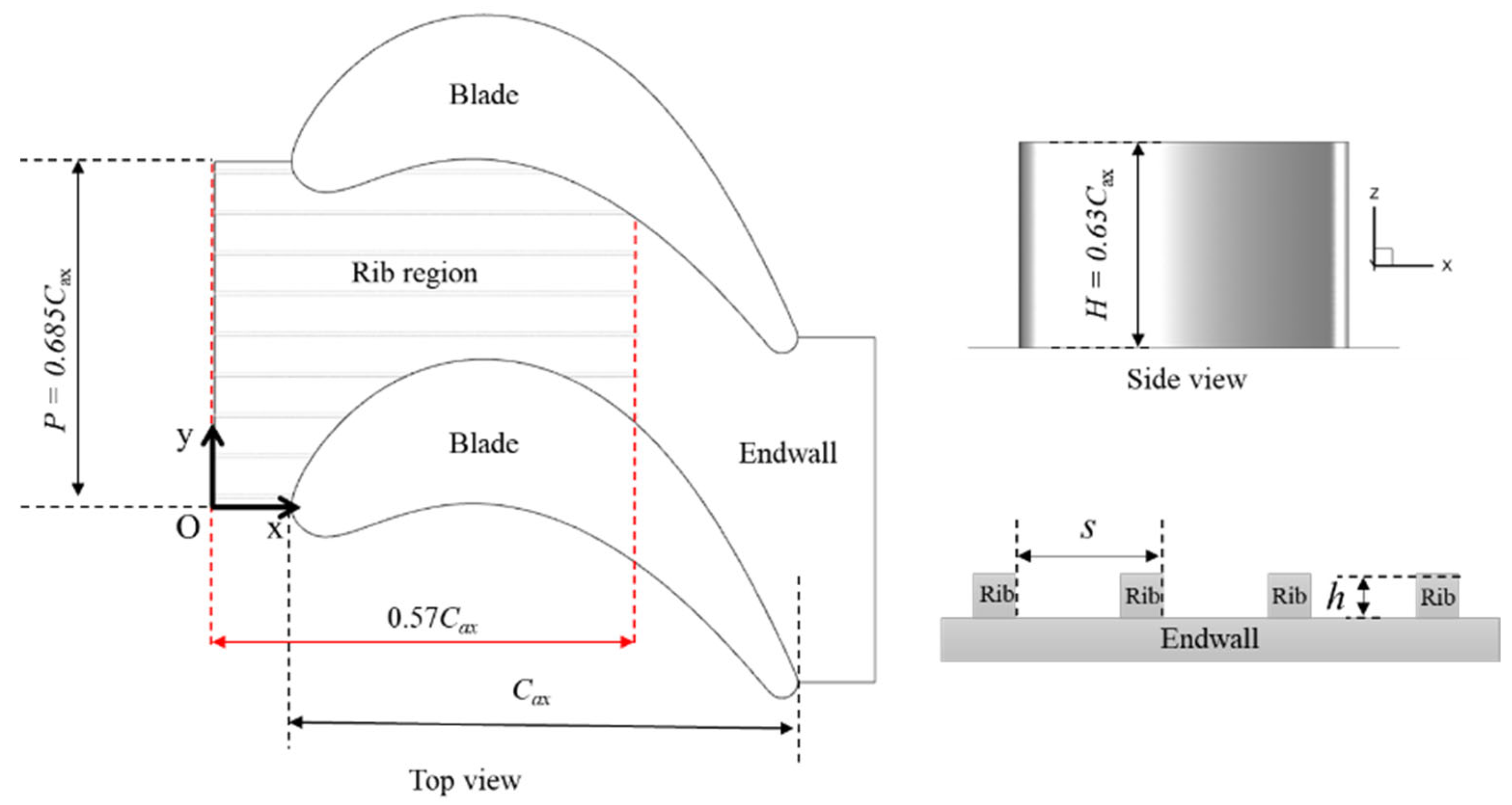
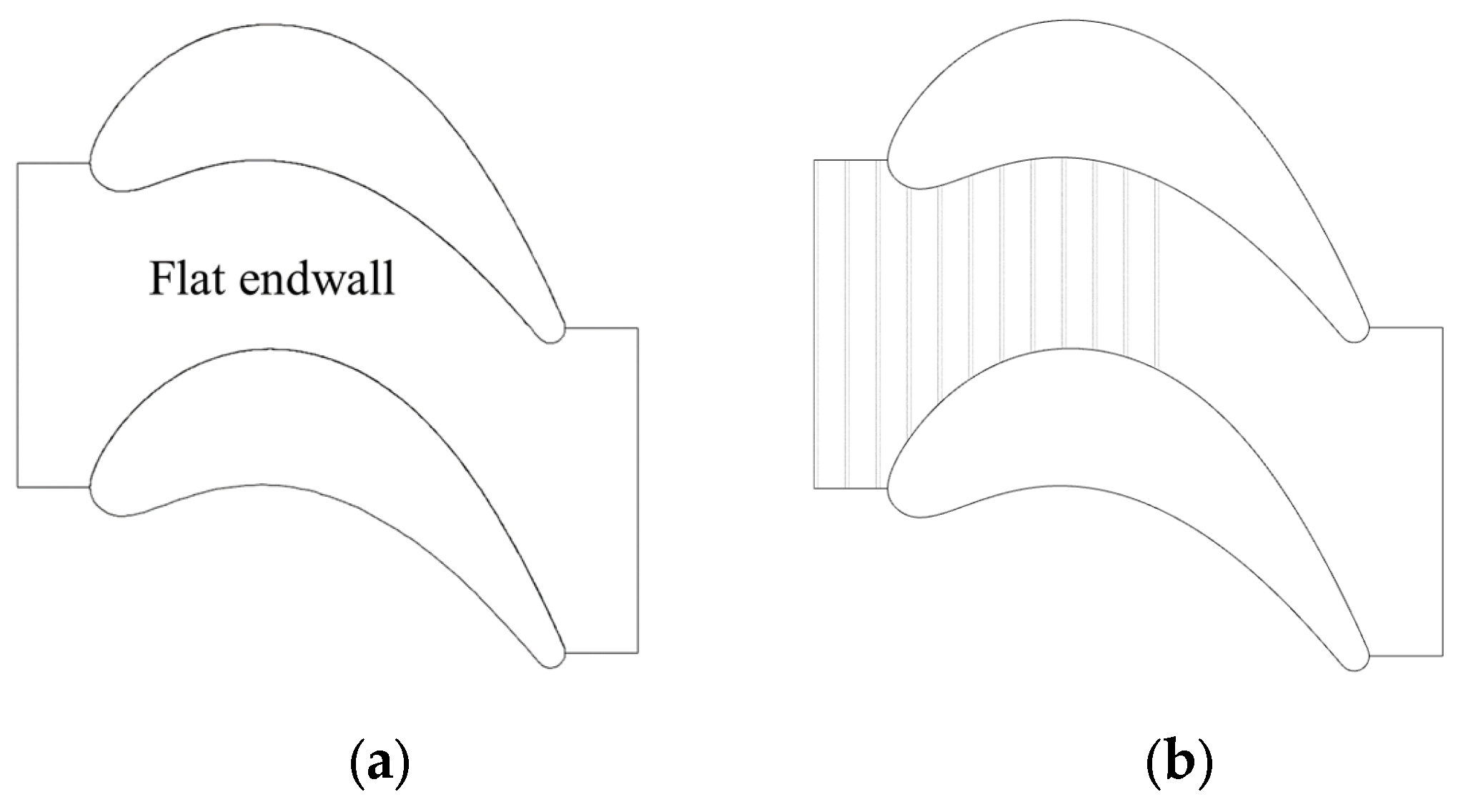
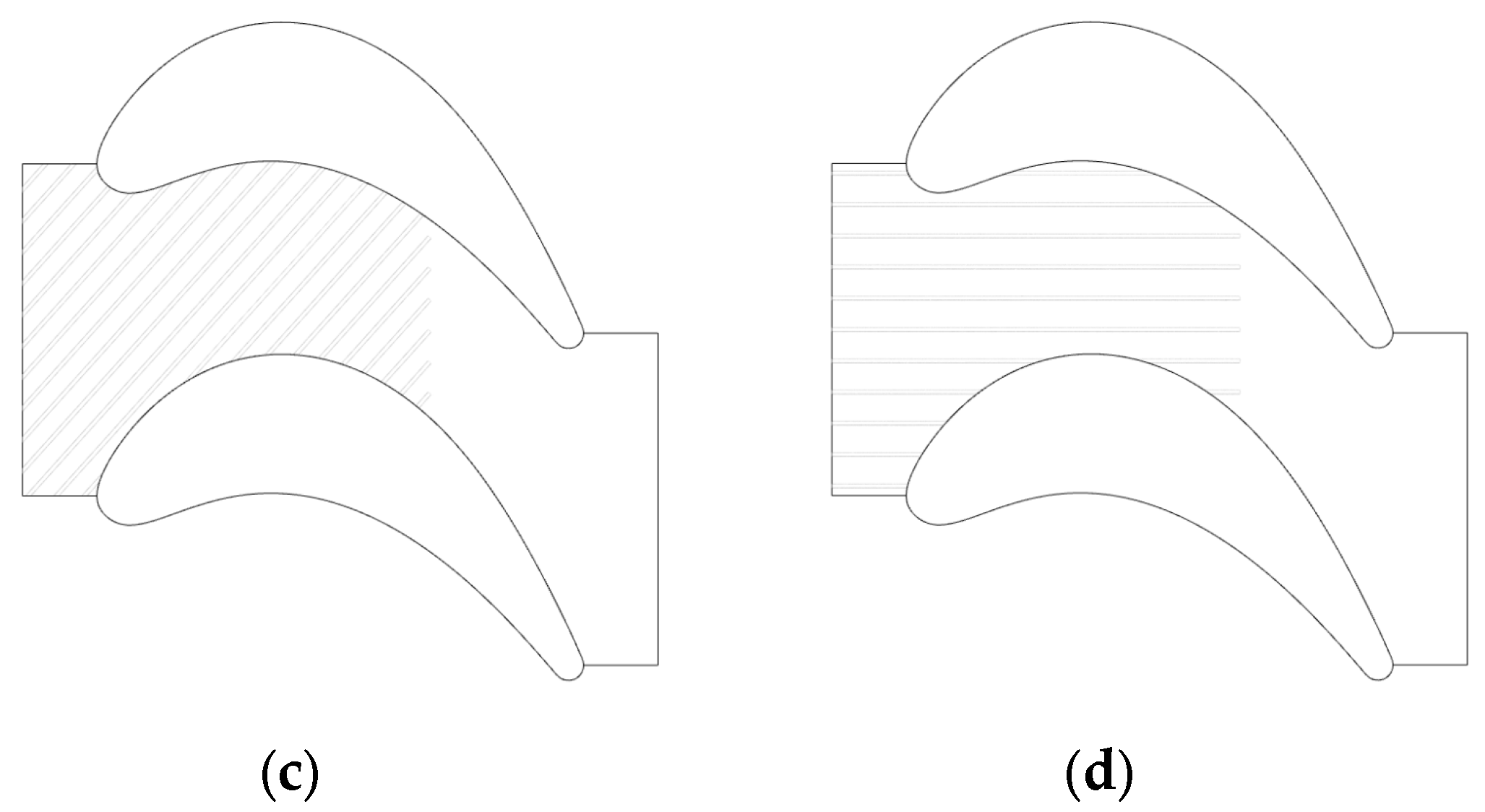

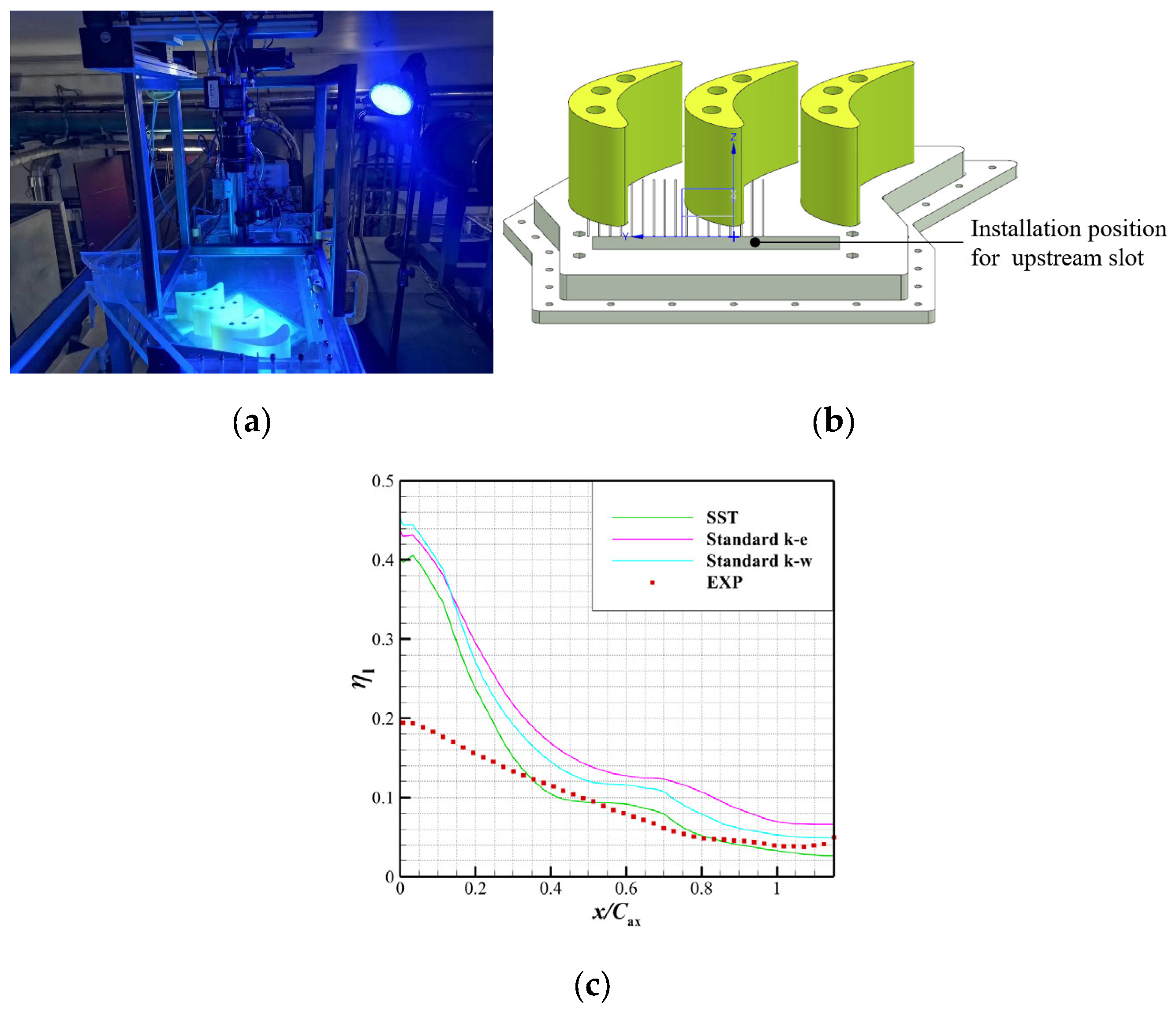

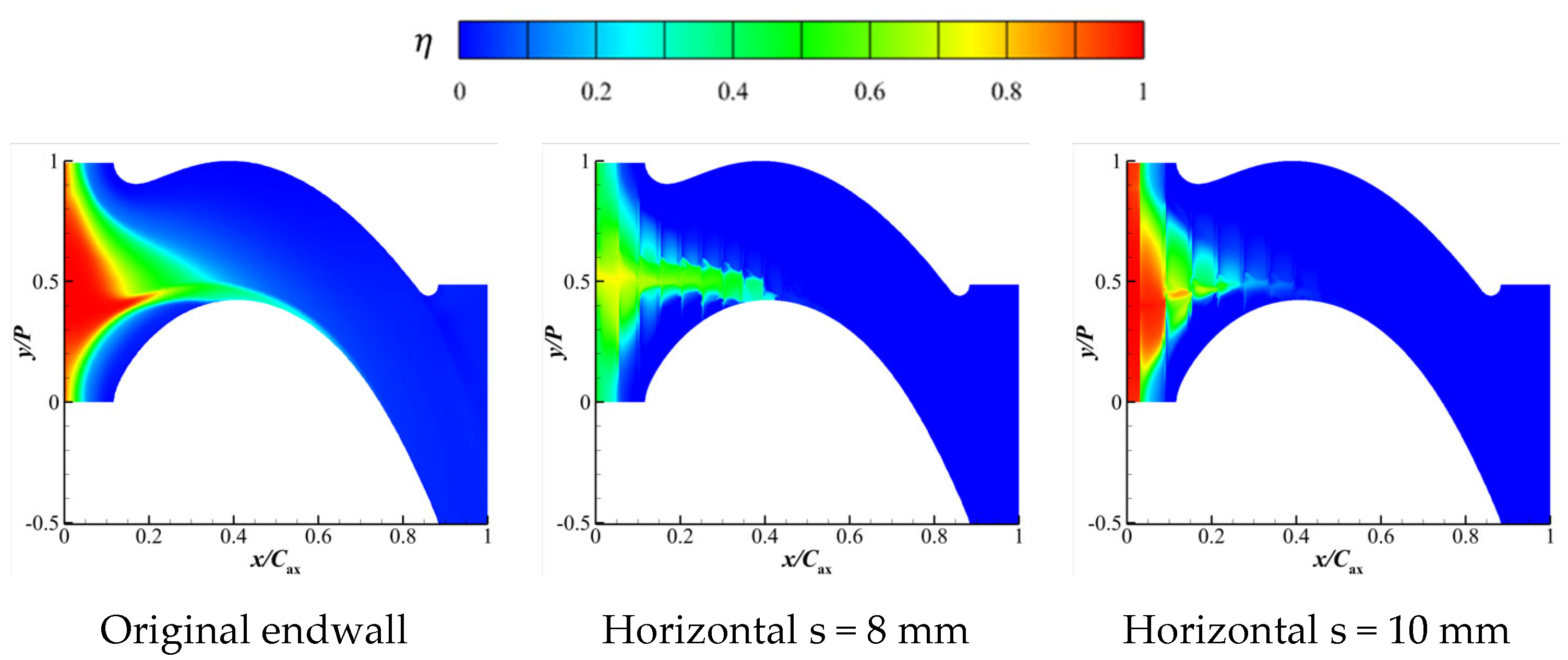

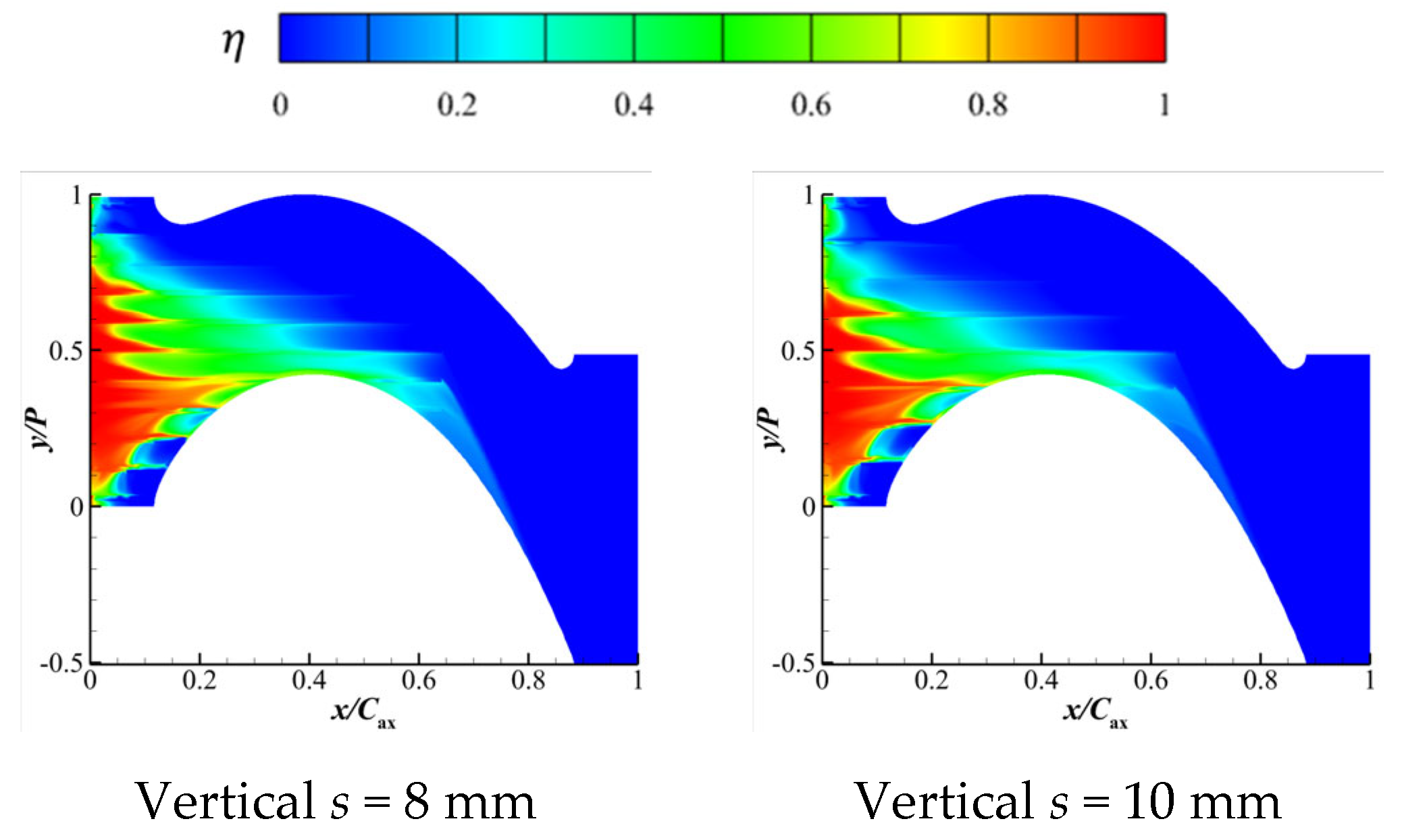
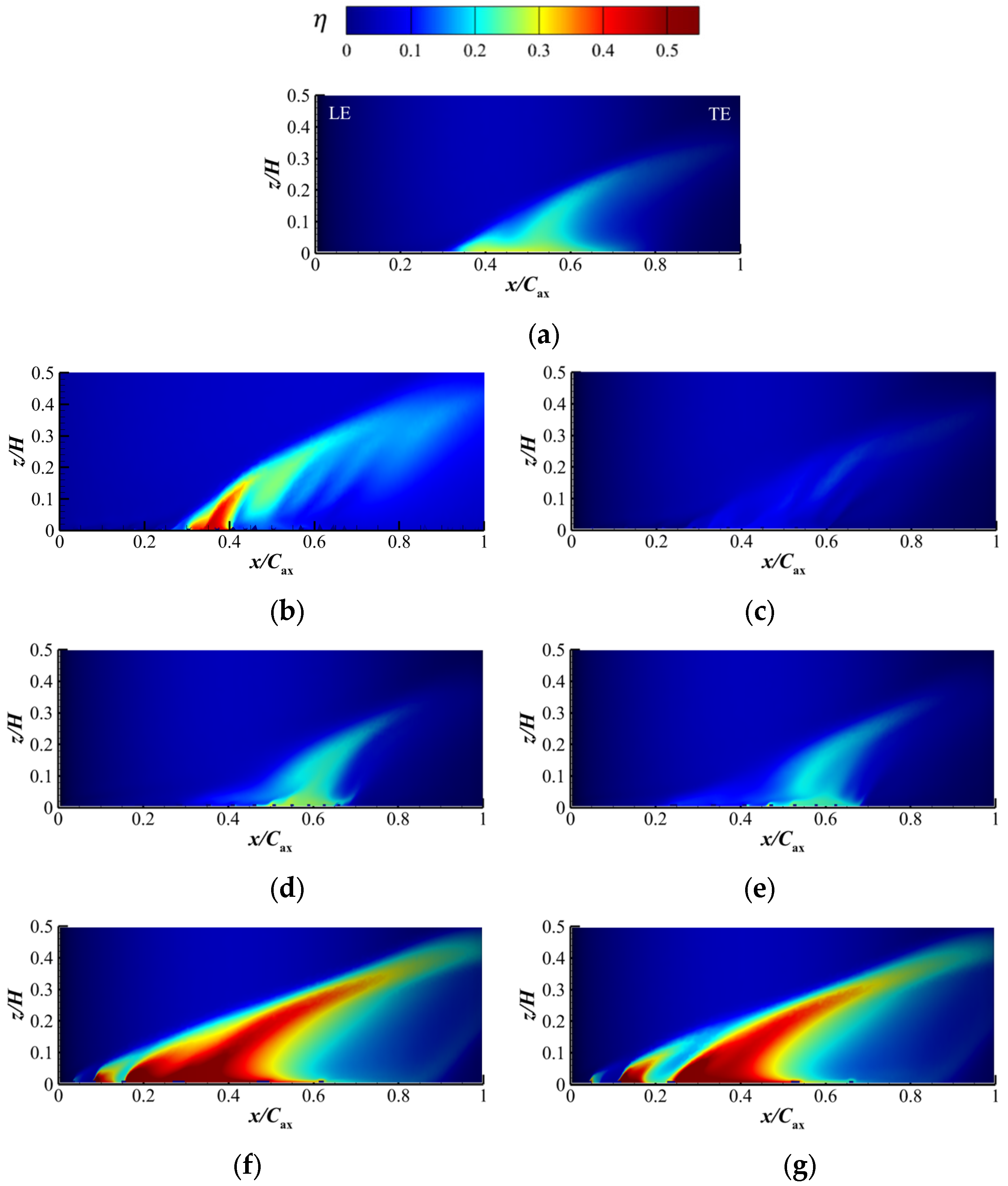


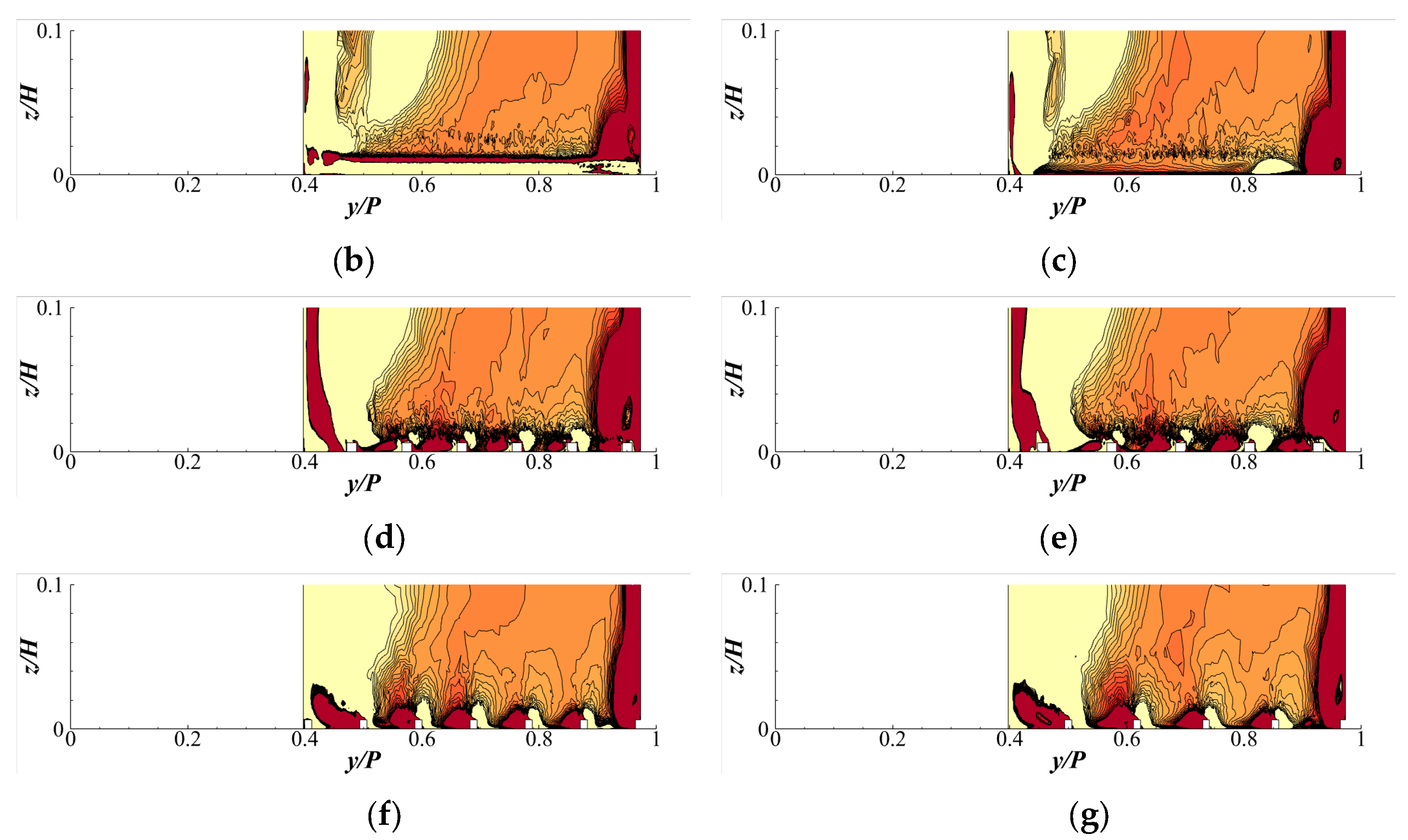
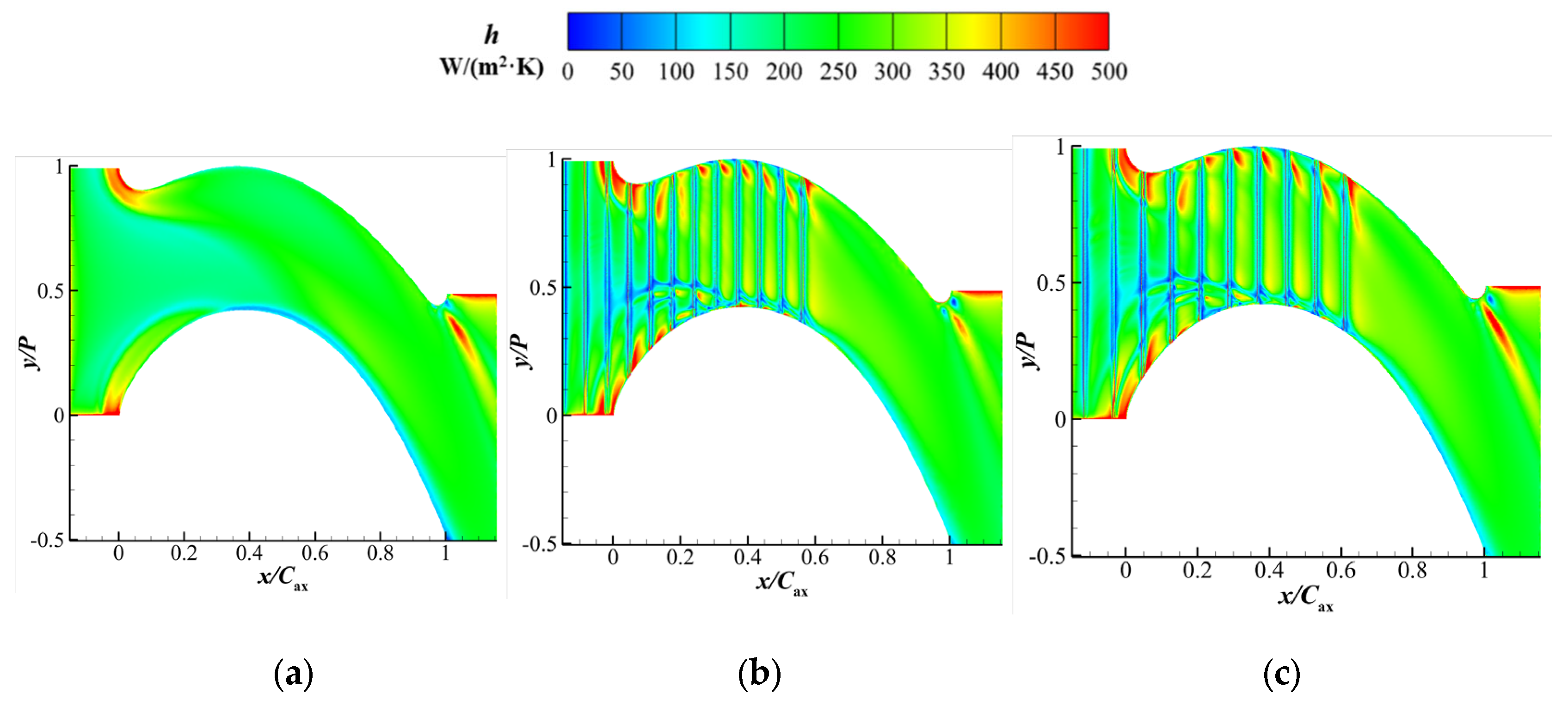

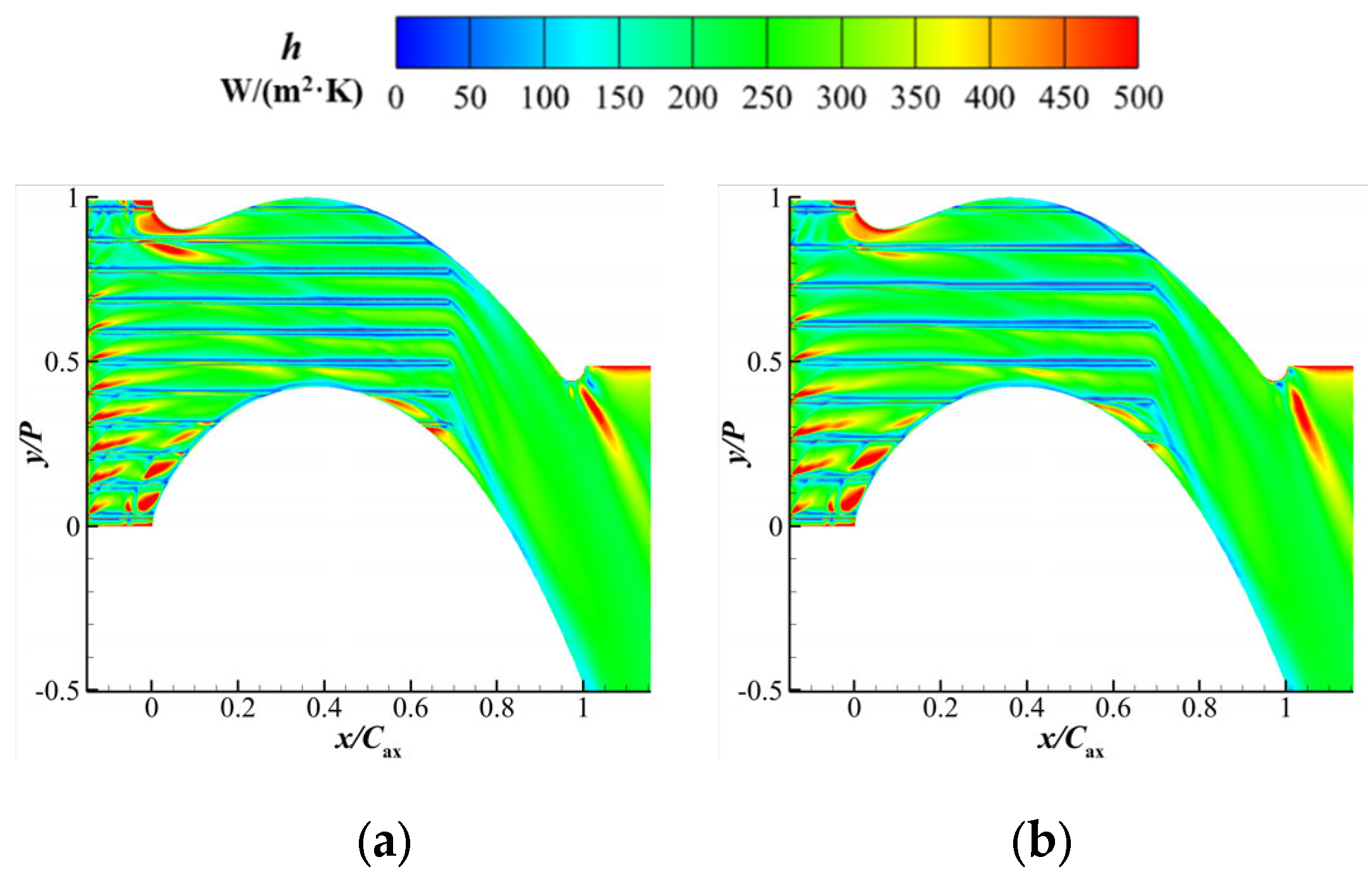

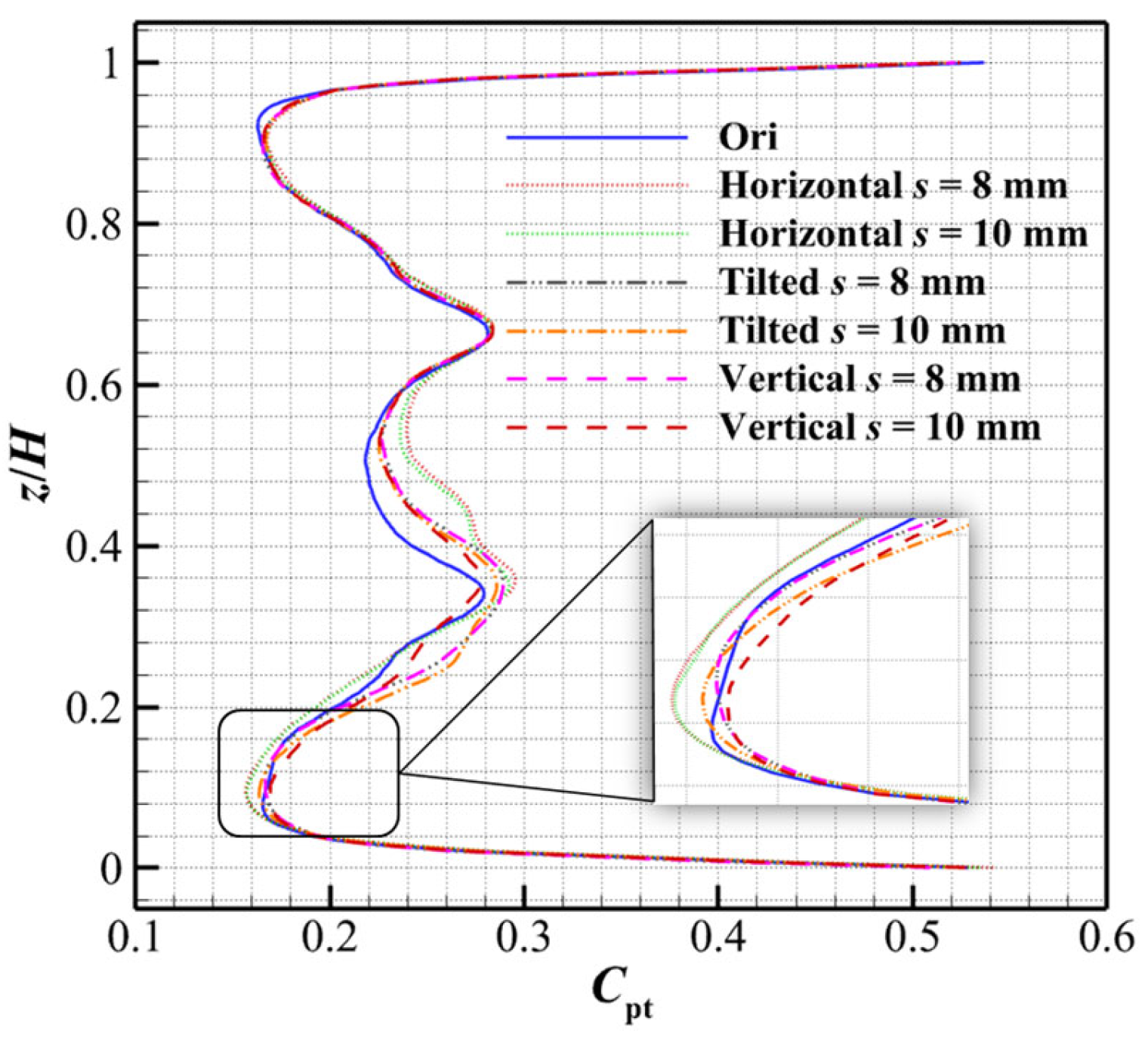

| Benefits | Demerits | |
|---|---|---|
| Contoured endwall |
|
|
| Non-axisymmetric endwall |
|
|
| Micro-scale rib |
|
|
| Chamfer of blade root |
|
|
| Mesh | Total Number of Cells | Area-Averaged | Deviation/% | GCI/% |
|---|---|---|---|---|
| Coarse | 23,989,236 | 0.16841 | 8.08 | —— |
| Moderate | 35,531,716 | 0.152809 | 1.93 | 3.17 |
| Fine | 66,834,042 | 0.155591 | 0.14 | 0.18 |
| Richardson extrapolation | —— | 0.155815 | —— | —— |
| Um (m/s) | 40 |
|---|---|
| Tm,in (K) | 298.15 |
| Tc,in (K) | 288.15 |
| MFR (%) | 1 |
Disclaimer/Publisher’s Note: The statements, opinions and data contained in all publications are solely those of the individual author(s) and contributor(s) and not of MDPI and/or the editor(s). MDPI and/or the editor(s) disclaim responsibility for any injury to people or property resulting from any ideas, methods, instructions or products referred to in the content. |
© 2023 by the authors. Licensee MDPI, Basel, Switzerland. This article is an open access article distributed under the terms and conditions of the Creative Commons Attribution (CC BY) license (https://creativecommons.org/licenses/by/4.0/).
Share and Cite
Liu, Z.; Song, Y.; Lu, Y.; Zhang, W.; Feng, Z. Numerical Study of Endwall Modification with Micro-Scale Ribs in a Turbine Cascade. Appl. Sci. 2023, 13, 12594. https://doi.org/10.3390/app132312594
Liu Z, Song Y, Lu Y, Zhang W, Feng Z. Numerical Study of Endwall Modification with Micro-Scale Ribs in a Turbine Cascade. Applied Sciences. 2023; 13(23):12594. https://doi.org/10.3390/app132312594
Chicago/Turabian StyleLiu, Zhao, Yu Song, Yixuan Lu, Weixin Zhang, and Zhenping Feng. 2023. "Numerical Study of Endwall Modification with Micro-Scale Ribs in a Turbine Cascade" Applied Sciences 13, no. 23: 12594. https://doi.org/10.3390/app132312594
APA StyleLiu, Z., Song, Y., Lu, Y., Zhang, W., & Feng, Z. (2023). Numerical Study of Endwall Modification with Micro-Scale Ribs in a Turbine Cascade. Applied Sciences, 13(23), 12594. https://doi.org/10.3390/app132312594








